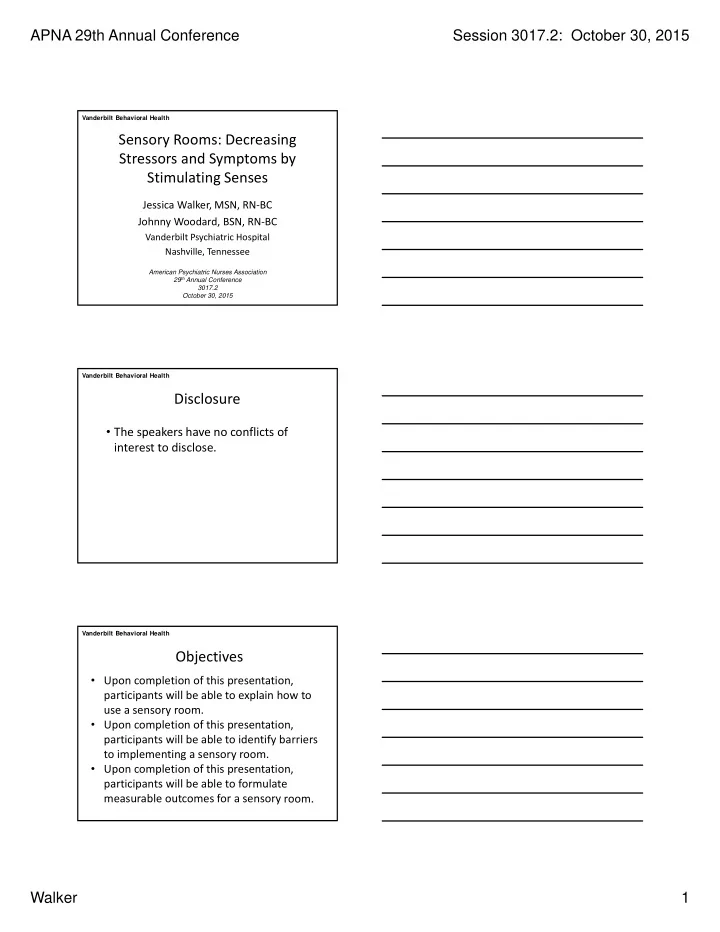

APNA 29th Annual Conference Session 3017.2: October 30, 2015 Vanderbilt Behavioral Health Sensory Rooms: Decreasing Stressors and Symptoms by Stimulating Senses Jessica Walker, MSN, RN ‐ BC Johnny Woodard, BSN, RN ‐ BC Vanderbilt Psychiatric Hospital Nashville, Tennessee American Psychiatric Nurses Association 29 th Annual Conference 3017.2 October 30, 2015 Vanderbilt Behavioral Health Disclosure • The speakers have no conflicts of interest to disclose. Vanderbilt Behavioral Health Objectives • Upon completion of this presentation, participants will be able to explain how to use a sensory room. • Upon completion of this presentation, participants will be able to identify barriers to implementing a sensory room. • Upon completion of this presentation, participants will be able to formulate measurable outcomes for a sensory room . Walker 1
APNA 29th Annual Conference Session 3017.2: October 30, 2015 Vanderbilt Behavioral Health A sensory room is the opposite of a seclusion room; it is a space that stimulates the senses of sight, hearing, taste, touch, and smell rather than depriving them. Vanderbilt Behavioral Health Vanderbilt Behavioral Health References • Champagne, T., & Stromberg, N. (2004). Sensory approaches in inpatient psychiatric settings: Innovative alternatives to seclusion and restraint. Journal of Psychosocial Nursing, 42 (9), 1 ‐ 8. • Costa, D. M., Morra, J., Solomon, D., Sabino, M., & Call, K. (2006). Snoezelen and sensory ‐ based treatment for adults with psychiatric disorders. OT Practice, 11 (4), 19 ‐ 23. • Cummings, K. S., Grandfield, S. A., & Coldwell, C. M. (2010). Caring with comfort rooms: Reducing seclusion and restraint use in psychiatric facilities. Journal of Psychosocial Nursing, 48 (6), 26 ‐ 30. • The Sensory Connection Program. (2008). Sensory room development: Ideas for creating and furnishing a sensory room. Retrieved from http://sensoryconnectionprogram.com/sensory_room3.pdf Evidence shows sensory rooms increase patients’ relaxation and cooperativeness and reduce seclusion and restraint. Sensory rooms have also been shown to reduce patients’ stress and agitation. Walker 2
APNA 29th Annual Conference Session 3017.2: October 30, 2015 Vanderbilt Behavioral Health Methodology • The number of seclusions and restraints on the unit the year prior to sensory room implementation and the year of sensory room implementation were collected through a database. • PRN medication usage on the unit the year prior to sensory room implementation and the year of sensory room implementation (haloperidol 5 mg, lorazepam 2 mg, chlorpromazine 50 mg, ziprasidone 20 mg, olanzapine 10 mg, and diphenhydramine 50 mg injections) were collected through the pharmacy. • Signs and symptoms were recorded by nursing staff before and after a patient used the sensory room (confusion, boisterousness, verbal threats, irritability, physical threats, attacks on objects, anxiety, and hallucinations). Vanderbilt Behavioral Health Implementation • The sensory room had at least 85 patient visits in 2014. Of the total sample, 54 patient visits had records completed on signs and symptoms experienced before and after using the room, and patients requested to use the room but had no signs or symptoms for 8 visits. • There were numerous positive reports from patients and staff. For example: • “This is just what I needed.” • “This room was very relaxing.” • “It was the only thing that could calm him down.” Vanderbilt Behavioral Health Results • There was a statistically significant reduction in the number of patient signs and symptoms recorded from before to after use of the room (p < .001). • There were not any differences found in type of restraint pre ‐ to post ‐ implementation. Furthermore, there was no statistically significant difference in the number of patients or duration of time in physical restraints. However, there was a substantial reduction in time in seclusion post ‐ implementation. • The mean number of PRN medications administered per day did not differ from pre ‐ to post ‐ implementation. However, nearly twice as many patients in the baseline group received PRN medications as compared to patients post ‐ implementation. Walker 3
APNA 29th Annual Conference Session 3017.2: October 30, 2015 Vanderbilt Behavioral Health Patient Scores Before and After Using Sensory Room Vanderbilt Behavioral Health Vanderbilt Behavioral Health Walker 4
APNA 29th Annual Conference Session 3017.2: October 30, 2015 Vanderbilt Behavioral Health Conclusions • This quality improvement project has determined that the sensory room is a beneficial de ‐ escalation tool for the adult inpatient thought disorders unit of Vanderbilt Psychiatric Hospital. In this study, there was a substantial impact on the • patients’ symptom report. There was also a decrease in number of people receiving medications. • Sensory rooms are feasible to implement in hospitals and are beneficial to both patients and staff as an effective de ‐ escalation tool. Vanderbilt Behavioral Health Acknowledgements • Vanderbilt University Medical Center’s Evidence Based Nursing Practice Fellowship 2011 ‐ 2012 (a year ‐ long program that enhances skills in finding and using evidence to guide nursing practice) guided this project. • Special thanks to: Jennifer Barut, MSN, RN ‐ BC; Elizabeth Card, MSN, RN, APRN, FNP ‐ BC, CPAN, CCRP; Avni Cirpili, RN, DNP, NEA ‐ BC; Mary Dietrich, PhD; Lori Harris, BSN, RN ‐ BC; Nancy Wells, DNSc, RN, FAAN; Johnny Woodard, BSN, RN ‐ BC; VPH 1 Nursing Staff; and Jill Clendening Walker 5
Recommend
More recommend